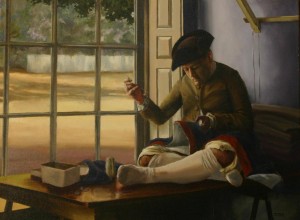 We use the term “parlorcraft” to refer to 19th-century handwork by people of all social classes. Parlorcraft is not limited to needlework, although all 19th-century women, and many boys, and nearly all sailors, would have been skilled at sewing and mending. For the working classes, sewing and mending clothing for the entire family was a necessity, but they also took in piece-work, dipped matches, fashioned paper flowers, and made other small items to be sold on the streets. For the middle- and some of the upper-classes, home sewing was still a necessity.
We use the term “parlorcraft” to refer to 19th-century handwork by people of all social classes. Parlorcraft is not limited to needlework, although all 19th-century women, and many boys, and nearly all sailors, would have been skilled at sewing and mending. For the working classes, sewing and mending clothing for the entire family was a necessity, but they also took in piece-work, dipped matches, fashioned paper flowers, and made other small items to be sold on the streets. For the middle- and some of the upper-classes, home sewing was still a necessity.
 Even a family affluent enough to afford the services of a dress-maker or tailor would still need to sew and mend underclothing, diapers, handkerchiefs, petticoats, and other garments. Young women were expected to sew and embroider items for their trosseau, to have table linens, lingerie, and night-gowns for their married life. For upper-class women who did not need to sew their family’s clothing, needle skills were the hallmark of an educated lady, as well as a leisure activity. Scrap-booking, painting china and glass, basket-weaving, watercoloring, lace-making, paper quilling, decoupage, hair-work, weaving and many other hand-crafts helped pass the time and create beautiful and useful objects. Nineteeenth-century men also engaged in hand crafts, such as leatherwork, whittling, and yes, knitting. Sailors had their own particular crafts, such as scrimshaw, cabinetry, rope-work, shell-work, and embroidery.
Even a family affluent enough to afford the services of a dress-maker or tailor would still need to sew and mend underclothing, diapers, handkerchiefs, petticoats, and other garments. Young women were expected to sew and embroider items for their trosseau, to have table linens, lingerie, and night-gowns for their married life. For upper-class women who did not need to sew their family’s clothing, needle skills were the hallmark of an educated lady, as well as a leisure activity. Scrap-booking, painting china and glass, basket-weaving, watercoloring, lace-making, paper quilling, decoupage, hair-work, weaving and many other hand-crafts helped pass the time and create beautiful and useful objects. Nineteeenth-century men also engaged in hand crafts, such as leatherwork, whittling, and yes, knitting. Sailors had their own particular crafts, such as scrimshaw, cabinetry, rope-work, shell-work, and embroidery.
The Parlorcraft Circle was launched by Society founders Eva and Zoh, and is currently hosted by Morgana Toglia and Rachel Klingberg. It meets approximately once a month depending on meeting space availability. The events are free and materials, instruction, and refreshments are generally provided by the hosts.
Past Parlorcraft Circles:
- April 2018: Fascinators
- March 2018: Reticules and Bow Ties (at the Hudson River Museum)
- December 2017: Paper Flowers, Cookie Swap, and Yuletide Social
- September 2017: Ribbon Embroidery, Trims, and Rosettes
- April 2017: Sailor’s Valentines and Decorative Knots
- December 2016: Snowflakes, Cookie Swap, and Yuletide Social
- September 2016: Handmade Books
- July 2016: Cravats, Jabots, and Ties
- June 2016: Wallets and Reticules
- March 2016: Embroidered Samplers (at the Mt. Vernon Hotel Museum)
- February 2016: Victorian Valentines
- January 2016: Handmade Shoes
- November 2015: Spencerian Script
- September 2015: Crochet
- August 2015: Tatted Lace
- July 2015: Smoking Caps
- December 2014: Tussie Mussies (Christmas edition)
- November 2014: Reticules and Scissors Cases
- October 2014: Papercraft (Halloween edition)
- September 2014: Embroidered Handkerchiefs and Lace Edgings
- November 2013: Free Sewing
- March 2013: Free Sewing
- October 2012: Swap Meet and Free Sewing
- August 2012: Gentlemen’s Accessories – Bow Ties and Suspenders
- April 2012: 19th Century Knitting
- February 2012: Show and Tell, Free Sewing
- December 2011: Knitted Sock Garters
- October 2011: Crocheted Lace
- May 2011: Victorian Embroidery
- April 2011: Free Sewing
- March 2011: Gaiters and Spats




